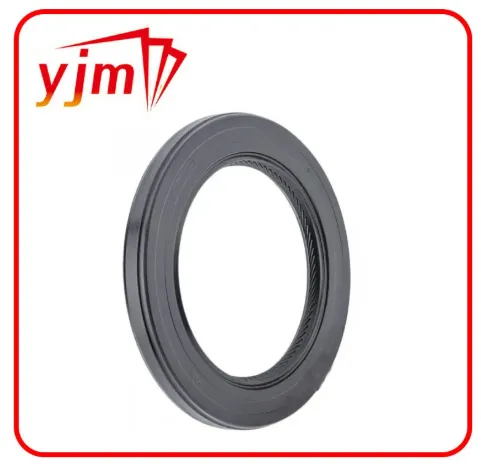Crankshaft Oil Sealing Systems: Protecting Engine Integrity from Within
The heart of every engine is the crankshaft, tirelessly converting combustion power into rotational force. But while the crankshaft performs a vital function, it must be securely sealed to maintain oil pressure, prevent leaks, and ensure overall engine health. Components like the crankshaft front oil seal, crankshaft gasket, and crankshaft main oil seal work together to keep the system tight and efficient. Neglecting these seals can lead to serious mechanical issues, making it essential for vehicle owners and technicians to understand their function, signs of failure, and replacement importance.

The Crankshaft Front Oil Seal: First Line of Defense Against Leaks
The crankshaft front oil seal sits at the front end of the engine, where the crankshaft exits the timing cover to connect to the pulley or harmonic balancer. This seal is exposed to extreme heat, oil flow, and constant rotation, making it one of the most crucial components in preventing engine oil from escaping the crankcase.
Why It Matters:
Prevents oil from leaking at the front crankshaft pulley
Keeps timing components free from oil contamination
Maintains internal oil pressure and proper lubrication
When a crankshaft front oil seal fails, you may notice:
Oil leaking from the lower front end of the engine
Oil splatter on the crank pulley or belts
A drop in oil level without external damage
Burning oil smells due to oil hitting hot components
Timely replacement of the crankshaft front oil seal during timing belt or pulley maintenance can save you labor costs and prevent further complications. Always inspect the crankshaft surface for scoring or wear, which may require polishing or a sleeve before installing a new seal.
Crankshaft Gasket and Gasket Seals: Ensuring a Tight and Lasting Fit
In addition to oil seals, gaskets play a crucial role in keeping your engine sealed and clean. The crankshaft gasket is typically used around the crankshaft housing or timing cover, forming a secondary barrier that complements oil seals. This gasket is usually made from composite materials or rubber to withstand oil, pressure, and vibration.
The crankshaft gasket seal refers to the combined effectiveness of both the gasket and the adjacent oil seal working in unison. If either fails, the system can leak oil and lose pressure.
Typical Areas Using a Crankshaft Gasket:
Timing chain cover to engine block
Oil pump housing to crankcase
Rear main seal housing to the block
Symptoms of a Faulty Crankshaft Gasket:
Persistent oil seepage near the front or rear of the engine
Gasket residue or fragments in oil
Low oil pressure or fluctuating levels
Engine knock caused by oil starvation
Replacing the crankshaft gasket or crankshaft gasket seal is essential whenever the crankcase is opened or timing components are accessed. Using high-quality gaskets with proper torque specs ensures the longevity of the entire sealing system.
Crankshaft Main Seals: Safeguarding the Engine Core
The crankshaft main oil seal, also known as the crankshaft main bearing seal, is responsible for sealing the ends of the crankshaft at both the front and rear. These seals are typically placed where the crankshaft connects to either the timing system (front) or the transmission flywheel/flexplate (rear).
The crankshaft main bearing seal is exposed to high-speed rotation and internal crankcase pressure, making it vulnerable to wear over time. A failure here can lead to not just oil leaks but also contamination of critical components like the clutch or torque converter.
Warning Signs of Main Seal Failure:
Major oil leaks at the front or rear of the engine
Engine oil on the clutch (manual) or flywheel housing (automatic)
Rough idling or performance issues due to slipping clutch
Oil dripping beneath the transmission area
Although the crankshaft main oil seal may seem minor, replacing it can be a major task—especially the rear main seal, which often requires removal of the transmission or engine. Because of the labor-intensive nature, this seal is often changed during other major services such as clutch replacement, engine rebuilds, or transmission work.
Preventative care tips:
Maintain proper crankcase ventilation to reduce internal pressure
Use the right oil weight and change it regularly
Replace seals when inspecting main bearings or oil pans
The crankshaft front oil seal, crankshaft gasket, crankshaft gasket seal, crankshaft main bearing seal, and crankshaft main oil seal are all vital components working together to preserve your engine’s lubrication and prevent oil loss. While they may not be visible or glamorous, their failure can cause major headaches—ranging from minor leaks to full engine damage.
Whether you’re a DIY enthusiast or a seasoned mechanic, understanding the importance and function of these crankshaft sealing components can help prevent premature wear, performance loss, and expensive repairs.
-
High-Quality Seal 12x22x5 for Industrial & Automotive Use | YJM Seal
Xov xwm Nov.25,2025
-
Seal 12x20x5: Precision Radial Shaft Seals for Industrial Reliability
Xov xwm Nov.24,2025
-
Seal 12x18x5: Essential Guide to Specifications, Applications & Vendors
Xov xwm Nov.24,2025
-
Understanding Seal 12 20 5: Applications, Specifications & Industry Insights
Xov xwm Nov.23,2025
-
Durable Oil Seal 85x110x12 – Reliable Sealing Solutions for Industry
Xov xwm Nov.23,2025
-
Durable and Precise Oil Seal 75x95x10 for Efficient Machinery | YJM Seal
Xov xwm Nov.22,2025
-
Durable Oil Seal 75x100x10 for Reliable Industrial Performance | YJM Seal
Xov xwm Nov.22,2025
Cov khoom qeb















